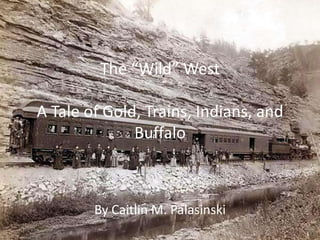
Powerpoint tech
- 1. The “Wild” West A Tale of Gold, Trains, Indians, and Buffalo By Caitlin M. Palasinski
- 2. The Great Railroad Race • In 1848 gold was discovered in California. • A transcontinental railroad was built to get to it. • Trains made travel shorter and cheaper. • Congress asked two train companies to start building the railway. • The companies were: – The Union Pacific Railroad. – The Central Pacific Railroad.
- 4. The Union Pacific Railroad • The head: Grenville Dodge. • Workers: “ former soldiers, African Americans, and Irish and German immigrants.” • Workers lived in a train that followed them. • The train had huge cars with bunk beds.
- 5. The Central Pacific Railroad • The head: Charles Crocker. • Most workers left company when they reached the Sierra Nevada. • The Company then hired mostly Chinese workers. • Other workers mistreated the Chinese workers. • This is because of prejudice.
- 6. How Train Tracks Were Made • Tools: Picks, shovels, and wheelbarrows. • The tools were used to make the road smooth. • Ties were put across the ground. • Iron Rails were placed on ties • The rails were held with spikes.
- 7. The “Wedding of the Rails” • The date was May 10, 1869. • Both railroads met at Promontory Point, Utah. • A telegraph was used to record when the “last spike” was driven into the ground. • It was celebrated all across the U.S. • Four more transcontinental railroads were built. • The railroad joining ceremony didn’t go smoothly.
- 8. Conflicts with the Indians • The Plains Indians had settled the West first. • Their way of life depended on buffalo. • The railroad brought many people. • The Indians attacked railroad workers. • Resulting in a fight with Union Pacific Railroad.
- 9. Conflicts with the Indians Continued • The government tried to stop the fight. • They sent the Indians to reservations. • The Indians wanted to hunt buffalo.
- 11. The Disappearing Buffalo • Buffalo were killed to force Indians to the reservations. • Less buffalo had dangerous consequences. • The Indians had to depend on the government. • They needed food but it was spoiled. • Or the food was sold. • The Indians rebelled.
- 12. The Battle of Little Bighorn • Occurred in 1876. • Between the army and the Sioux. • Gold was found in the Black Hills. – Where: on Sioux land. – Government wanted them to leave. – Sioux planned to fight. – The government sent troops to capture them.
- 13. The Battle of Little Big Horn Continued • The Indians were led by: – Sitting Bull and Crazy Horse. • The Armed Forces were led by George Custer. – Plan: to find Indians and wait for reinforcements. – What happened: Custer attacked. • Results: • Custer and his men all died. • This is considered “the Sioux’s last victory.
- 14. Faces of the Battle George Custer Chief Crazy Horse Sitting Bull
- 15. “The Nez Perce’s Long March” • The government wanted the Indians to move to a reservation. • Young Indians rebelled. • The Indians had to escape to Canada. • They fought 13 battles. • They walked over 1,000 miles • 40 miles from Canada they were captured. Chief Joseph
- 16. Final Words • The railroad caused: • Huge changes in travel • Conflict with the Indians • Changes in everyday life
- 17. Works Cited All of the information is from the book: Banks, James A., et. al. United States And its Neighbors: Teacher’s Edition. New York: Macmillan/McGraw-Hill School Publishing Company, 1993. Print. • Slide 1, picture 1: http://www.old-picture.com/old-west/Passenger-Train-West-Old.htm • Slide 3, picture 1: http://mrberlin.com/transcontinentalrailroad.aspx • Slide 4, picture 1: http://transportationheroes.org/heroDetail.php?id=22 • Slide 4, picture 2: http://www.sciencephoto.com/media/155765/enlarge • Slide , picture 1: http://www.asianweek.com/2012/01/04/significant-dates-in-asian-americanchinese-american-history/ • Slide 5, picture 1: http://www.kued.org/productions/chineseamerican/resources/photos_ushs.html • Slide 6, picture 1: http://www.britannica.com/EBchecked/media/95565/Workers-laying-tracks-for-the-Central-Pacific- Railroad-in-Nevada • Slide 8, picture 1: http://westernsreboot.com/ • Slide 12, picture 1: http://lprewittmccracken.weebly.com/important-information-about-native-americans.html • Slide 14, picture 1: http://www.flickr.com/photos/43619751@N06/4098309687/ Slide 14, picture 1: Chuck_893, “Maj. Gen G. A. Custer” November 18, 2011 via Flickr, Creative Commons Attribution. • Slide 14, picture 2: http://farm3.staticflickr.com/2582/5795511910_79dd6723b3.jpg Slide 14, picture 2: Pearlmatic, “1885 Sitting Bull by David Frances Barry” June 3, 2011 via Flickr, Creative Commons Attribution. • Slide 14, picture 3: http://www.flickr.com/photos/64609450@N08/5876439356/sizes/m/in/photostream/ Slide 14, picture 3: Wanagi Ska, “Chief Crazy Horse, Lakota” June 27, 2011 via Flickr, Creative Commons Attribution. • Slide 15, picture 1: http://www.flickr.com/photos/gizart68/5198527129/ Slide 15, picture 1: John Patterson, “Chief Joseph 30"x42“” September 18, 2010 via Flickr, Creative Commons Attribution. • Slide 16, picture 1: http://www.schillerinstitute.org/lar_related/2008/lar_maglev_conf.html